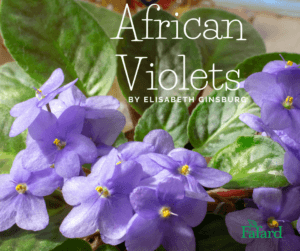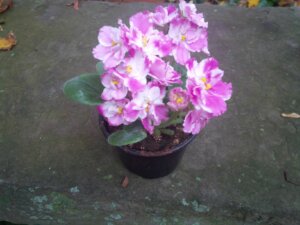
The National Garden Bureau has decreed that 2024 is the “Year of the African Violet”. Coming in January, generally a dark, cold month, this boost for a cheerful little plant couldn’t be more timely.
Plant names can be great deceivers, but in the case of African violets (Saintpaulia ionantha), the common name is at least partly right. The ancestors of modern African violets did indeed live on the African continent, in mountainous cloud forest regions of today’s Kenya and Tanzania. Though the flowers bear a superficial resemblance to those of members of the violet or Violaceae family, African violets are not related to them. They are gesneriads, belonging to the Generiaceae family along with other popular blooming houseplants, like primulina, streptocarpus, and gloxinia.
Like their gesneriad relatives, African violets produce rosettes of evergreen leaves. Those leaves are rounded, somewhat fleshy, and covered with soft hairs. The flowers are on slender stalks and have five petals apiece—two upper petals and three, slightly larger lower ones. The petals may appear equal in many modern violet varieties. If you look at the flowers closely, you will notice that the petals’ bases fuse into a tube, another gesneriad characteristic.

In the nineteenth century, cradles of biodiversity in Africa, South America, and Asia were rife with European adventurers, some of whom were keen amateur or even professional botanists. One such amateur was Prussian nobleman Walter von Saint Paul-Illaire, who, during the 1890s, served as a bureaucrat for the German East Indian Company. Hiking through the Usambara mountains of eastern Tanzania, he discovered the low-growing plants that were eventually named in his honor. The baron sent seeds back to Europe and the saintpaulia craze began.
Serious breeding efforts began in the United States in the 1920s and eventually, thousands of African violet varieties were developed. The African Violet Society of America, now the world’s largest interest group devoted to a single indoor plant, was organized in 1946. In its role as the international cultivar registration authority for Saintpaulia, the AVSA is the African violet world’s “keeper of the keys.” Amateur and professional violet breeders must register their new creations with AVSA before they can be recognized as unique varieties.
African violets are inexpensive and accessible, available everywhere, from supermarkets to big box stores. Many of those plants, especially the trademarked Optimara violets, come from the world’s largest African violet supplier, Herman Holtkamp Greenhouses in Nashville, Tennessee.

The plants’ popularity owes much to the fact that they are relatively unfussy and thrive in indoor situations where light is somewhat less than optimal. All you need is a relatively warm room, bright diffuse light and well-drained potting soil. Relatively high humidity is not necessary, but the plants will appreciate either a humidifier or a perch atop a pebble and water-filled tray. The pots should sit atop the pebbles, not directly in the water, lest the water-logged situation cause crown rot, which is deadly to African violets. For safety’s sake, water only when the soil surface feels dry to the touch and direct the stream of water towards the edges of the pot, rather than directly at the plant’s crown. This also avoids water spotting on those fuzzy leaves. Your African violets will also appreciate regular applications of plant food marketed especially for the species, applied according to manufacturers’ directions.
While choice is sometimes limited in local retail stores, online vendors offer a host of options. Breeders have created plants in several sizes, grouped according to the width of the basal rosette of leaves. Miniature violets are six to eight inches or less in diameter, semi-miniatures grow six to eight inches wide, standard varieties span eight to 16 inches, and large African violets feature leaf rosettes that are over 16 inches wide.

Trailing varieties, suitable for pedestals and baskets, are also available. Blooms may be single, double, or appear as bursts of exuberantly ruffled petals. Flower colors range from white through pink, a host of purples, pale green, and even yellow. Some varieties sport bi-colored petals. Leaves may be green or variegated and shapes also vary widely, from the textured loveliness of “quilted” leaves to the pointed-sided “holly” types.

You can buy African violets almost anywhere, generally for a song. For something more unusual, the AVSA also has a listing of vendors located on their website.

